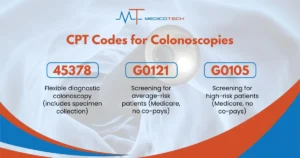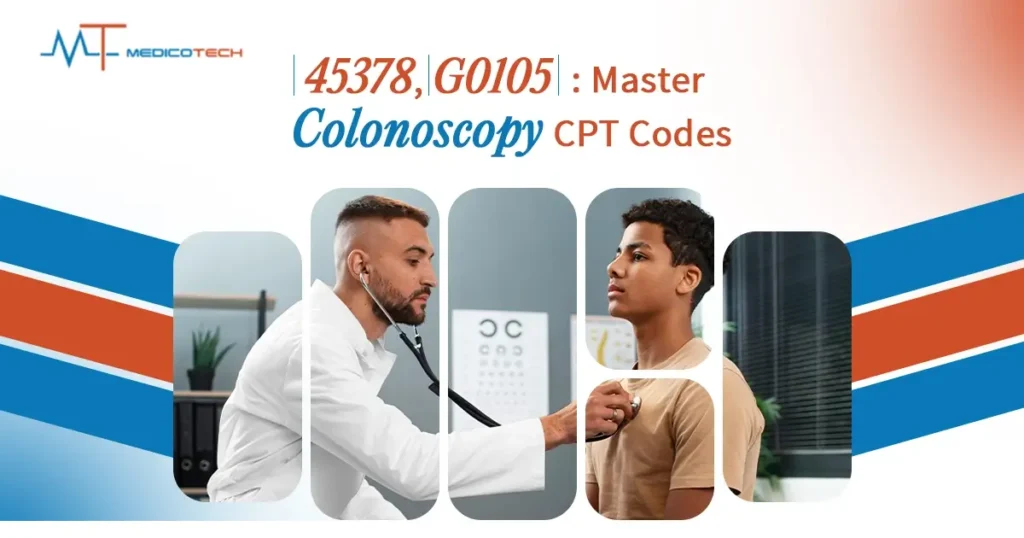CPT codes are necessary in colonoscopy in order to establish maximum documentation of a procedure, and correct reimbursement. Colonoscopies are major diagnostic tools and preventive that assist in the prevention of colorectal cancer and other G.I problems. We will see in this comprehensive guide the categories of colonoscopies, important CPT codes, modifiers, and optimal strategies to approach proper billing.
Introduction to Colonoscopy CPT Codes
A colonoscopy is a physician operation which involves the physician who, with the aid of the colonoscope, a flexible tube, examines the lining of the colon (large intestine) and the rectum. This may be applied to a wide variety of objectives, e.g., in screening colorectal cancer, the determination of diverse gastrointestinal symptoms, or the treatment task, e.g., polyp removal. Colonoscopies also serve an extreme role in the early diagnoses of the colorectal cancer and in most cases, polyps can be removed before they can become cancerous.
Importance of Accurate Coding in Colonoscopy for Proper Reimbursement
Proper coding of colonoscopy CPT codes is critical not just to provide the right reimbursement, but also being in line with the insurance policies and Medicare policies. Selecting the right CPT codes and modifiers allows providers to take advantage of more accurate claims that will not be rejected or delayed, as well as prevent audits. As an example, when a procedure performed as a screening colonoscopy becomes therapeutic, proper application of the modifiers can guarantee that the patient is not overcharged with extra money, which is dictated by the policies on preventive care. Correct coding controls are needed to make sure that the providers receive fair prices on routine and complex procedures.
Understanding the Types of Colonoscopy Procedures
Screening Colonoscopy:
Screening colonoscopy is usually Done in generally asymptomatic people as precautionary care. This is mainly done to screen colon cancer, polyps and other malignancies in the development of the colon in persons without symptoms. 初amiligan consulado people who begin screening as early as age 45 or before depending on the family history of colorectal cancer should have screenings regularly.
Key Codes and When to Use
Screening colonoscopy is coded as 45378 (CPT). This code is applied to a diagnostic colonoscopy only (no other intervention such as biopsy or polyp to be removed). Also, HCPCS G0105 and G0121 are applied to Medicare patients, where G0105 is assigned to high-risk patients and G0121 is assigned to population at average risk.
- CPT Code: 45378
- ICD-10 Diagnosis Code: Z12.11 (Encounter for screening for malignant neoplasm of the colon)
Diagnostic Colonoscopy:
Explanation and Purpose
A diagnostic colonoscopy is performed when a patient presents with symptoms such as rectal bleeding, abdominal pain, or unexplained weight loss, and the procedure is used to investigate or diagnose a condition. Unlike screening, diagnostic colonoscopies are done in response to symptoms or abnormal findings from other tests. CPT code 97110, which is generally used for therapeutic procedures such as physical therapy or muscle strength interventions, would not be used here as it applies to different types of treatments outside the colonoscopy scope.
Appropriate CPT Codes
The same CPT code 45378 is used for a diagnostic colonoscopy, but the procedure is typically more focused on evaluating and confirming suspected conditions. For cases where biopsies or removal of abnormal tissue is necessary, additional codes are applied.
- CPT Code: 45378
- ICD-10 Diagnosis Code: Based on the symptoms or condition being investigated (e.g., K63.5 for polyps of the colon).
Therapeutic Colonoscopy:
Interventions and Treatments Performed
A therapeutic colonoscopy involves treating conditions discovered during the colonoscopy. These treatments might include removing polyps, controlling bleeding, or other interventions such as stent placement. Therapeutic colonoscopies are typically more complex and require more specific coding.
CPT Code Selection
For a therapeutic colonoscopy, the CPT code selection depends on the specific procedure performed. For instance, 45385 is used when tumors or polyps are removed using a snare technique, while 45380 is used for biopsies.
- CPT Code: 45385 (for snare polypectomy), 45381 (for directed submucosal injection), or 45382 (for bleeding control).
Surveillance Colonoscopy:
For Patients with Previous History
A surveillance colonoscopy is a follow-up procedure for individuals who have had previous colorectal issues, such as polyps, cancer, or inflammatory bowel disease. This procedure is typically scheduled more frequently than a regular screening colonoscopy, depending on the patient’s history.
Differences from Screening and Diagnostic Colonoscopies
Surveillance colonoscopies are often considered a type of screening, but they are specifically aimed at monitoring known issues from past procedures. They should be coded correctly to reflect their purpose in maintaining the patient’s health.
- CPT Code: 45378
- ICD-10 Diagnosis Code: Z86.010 (Personal history of colonic polyps)
CPT Codes for Diagnostic and Screening Colonoscopies

45378: Colonoscopy, Flexible; Diagnostic
This is the base CPT code for diagnostic colonoscopies. It’s used for both screening and diagnostic purposes when no additional procedures (like biopsies or polyp removal) are performed. The code includes collection of specimens when necessary.
G0121: Colorectal Cancer Screening for Average-Risk Patients (Medicare)
This HCPCS code is used specifically for Medicare patients who are at average risk for colorectal cancer. It’s part of the preventive services covered under Medicare without requiring co-pays or deductibles.
G0105: Colorectal Cancer Screening for High-Risk Patients (Medicare)
This HCPCS code applies to Medicare patients who are at high risk due to a family history or other risk factors. Like G0121, it is covered under Medicare’s preventive service guidelines.
Colonoscopy Intervention Codes for Biopsy and Polypectomy
45380: Colonoscopy with Biopsy (Single or Multiple)
This code applies when a biopsy is performed during a colonoscopy to collect tissue samples for further examination.
45383: Colonoscopy with Removal of Tumors, Polyps, or Lesions by Snare Technique
Used when polyps or tumors are removed with a snare during the colonoscopy.
45385: Colonoscopy with Removal of Tumors, Polyps, or Lesions by Hot Biopsy Forceps
This code applies when hot biopsy forceps are used to remove polyps or other lesions from the colon.
Modifiers for Colonoscopy CPT Codes
Modifier 33: Preventive Service
This modifier is appended to the CPT code for screening colonoscopies when billed for commercial insurance or Medicaid. It triggers the preventive service designation, ensuring that the patient does not have to pay a deductible or co-pay for the screening.
Modifier PT: Colorectal Cancer Screening Converted to Diagnostic or Therapeutic
When a screening colonoscopy turns into a diagnostic or therapeutic procedure (e.g., polyp removal), modifier PT should be appended. This ensures that the procedure is still classified as preventive for billing purposes, which waives the deductible for Medicare patients.
How to Code Colonoscopies for Medicare and Commercial Insurance
Medicare Coding:
Medicare uses specific coding guidelines for colonoscopies, including the use of HCPCS codes for screening procedures. These codes are vital for ensuring that Medicare patients receive the correct preventive care without unnecessary out-of-pocket expenses.
Using G0105, G0121 for Screening and High-Risk Cases
- G0105 is used for screening colonoscopies on Medicare patients who are high-risk for colorectal cancer due to a family history, personal history of polyps, or conditions like inflammatory bowel disease.
- G0121 is used for average-risk individuals undergoing a routine screening colonoscopy.
Both these codes fall under preventive services and are reimbursed at 100%, which means Medicare covers the cost without a co-pay or deductible. It’s important to note that these codes should be used according to the patient’s risk category, and the documentation must clearly indicate whether the patient is at high risk.
Important Guidelines for Medicare Reimbursement:
- Screening Interval: Medicare covers screening colonoscopies every 10 years for individuals at normal risk and every 24 months for high-risk patients.
- Modifier PT: When a screening colonoscopy converts to a diagnostic or therapeutic procedure, modifier PT must be appended to the CPT code to indicate that the procedure started as a screening. This allows Medicare to waive the deductible, though coinsurance still applies.
Commercial Insurance Coding:
Coding for commercial insurance may vary depending on the payer, but the basic principles remain the same. Colonoscopy procedures should be billed using CPT codes with the appropriate modifiers.
Use of CPT Codes with Modifiers 33
- Modifier 33 is used to identify a preventive service and ensures that the patient does not have to pay any co-pays or deductibles for a screening colonoscopy.
- Commercial payers may have different reimbursement guidelines, so it is crucial to check the specific insurance policy for any variations or additional requirements.
Navigating Insurance Policies and Payment:
- Understand the payer’s policy on screening vs. diagnostic procedures, especially when a procedure converts from screening to therapeutic.
- For Medicaid and commercial insurance, use modifier 33 to avoid patient cost-sharing when performing screening colonoscopies.
When to Use Modifier 33 for Preventive Screening Colonoscopies
Modifier 33 Explained:
Modifier 33 is an essential tool when coding for preventive services, specifically screening colonoscopies. This modifier indicates that the primary purpose of the procedure is preventive, in line with US Preventive Services Task Force (USPSTF) recommendations for colorectal cancer screening.
- Purpose: Modifier 33 ensures that a screening colonoscopy is processed as a preventive service, meaning the patient is not responsible for any co-pays, coinsurance, or deductibles.
- When to Use: Modifier 33 should be appended to the CPT code 45378 (or other colonoscopy-related codes) when the procedure is a screening colonoscopy, ensuring the procedure is considered preventive.
How It Triggers Preventive Benefits and Waives Co-pays/Deductibles:
When modifier 33 is used, insurance companies are instructed to process the claim as a preventive service. As a result, the patient won’t face co-pays or deductibles, making it easier for patients to access colorectal cancer screenings without worrying about financial barriers.
- Example 1: A patient with no symptoms undergoes a routine screening colonoscopy as part of their preventive care. Modifier 33 is appended to ensure the procedure is covered under preventive benefits.
- Example 2: A commercial insurance policy covers screening colonoscopies without a co-pay, and modifier 33 ensures that the claim is processed correctly.
Examples of Modifier 33 Application:
- Medicare: Modifier 33 is not typically required for Medicare since preventive screening is already covered under Medicare guidelines.
- Commercial Insurance and Medicaid: For these insurers, modifier 33 is crucial for ensuring the procedure is treated as a preventive service, especially if it’s a routine screening.
The Role of Modifier PT in Converting Screening Colonoscopies to Diagnostic
Understanding Modifier PT:
Modifier PT is used when a screening colonoscopy transitions into a diagnostic or therapeutic procedure. This could happen if polyps are discovered and removed, or a biopsy is performed during the screening.
- Purpose: This modifier indicates that the procedure started as a preventive screening but became diagnostic or therapeutic due to the findings during the procedure.
- When to Use: Modifier PT should be added when a screening colonoscopy leads to a therapeutic intervention, such as polyp removal, to ensure that the procedure remains classified as a screening for billing purposes.
When Screening Turns into Diagnostic or Therapeutic:
- A polyp is found during a screening colonoscopy, and the doctor removes it. The procedure is now both diagnostic (investigating the polyp) and therapeutic (removing the polyp).
- Modifier PT ensures that the procedure remains covered under preventive benefits, meaning the patient is not responsible for a deductible, though coinsurance might still apply.
Impact on Medicare Billing:
For Medicare patients, modifier PT ensures that when a screening turns diagnostic, the deductible is waived, but coinsurance will still be applicable. This modifier helps maintain preventive care coverage and prevents billing issues.
Common Diagnosis Codes for Colorectal Cancer Screening Colonoscopies
Accurate ICD-10 codes are essential for correctly classifying the reason for the colonoscopy. Below are some of the most common diagnosis codes used in conjunction with colonoscopy CPT codes:
Z12.11: Encounter for Screening for Malignant Neoplasm of Colon
This code is used for a routine screening colonoscopy in patients without symptoms or a known diagnosis of colorectal cancer.
- When to Use: For asymptomatic patients undergoing routine screening.
- Example: A healthy 50-year-old patient with no symptoms undergoes a screening colonoscopy as part of preventive care.
Z80.0: Family History of Malignant Neoplasm of Digestive Organs
This code is used when the patient has a family history of colorectal cancer or other digestive organ cancers. It indicates that the patient is at a higher risk for colorectal cancer.
- When to Use: When the patient has a family history of cancer, and the colonoscopy is conducted as a preventive measure.
- Example: A patient with a family history of colorectal cancer seeks a screening colonoscopy.
Z86.010: Personal History of Colonic Polyps
This code is used for patients with a history of polyps. A surveillance colonoscopy is typically recommended for such patients to monitor for any recurrence of polyps.
- When to Use: For patients who have had polyps in the past and need regular screenings.
- Example: A patient with a history of colon polyps returns for a surveillance colonoscopy.
Reimbursement and Billing Best Practices for Colonoscopies
Maximizing Reimbursement:
Accurate coding and documentation are the cornerstones of maximizing reimbursement for colonoscopy procedures. To ensure you are reimbursed fully, it’s essential to:
- Choose the correct CPT code for the procedure type.
- Use appropriate modifiers (e.g., modifier 33, modifier PT) to reflect whether the procedure is preventive or therapeutic.
- Document the patient’s medical history (e.g., family history of cancer or personal history of polyps) to support the need for the procedure and the frequency of screenings.
Proper Coding for Colonoscopy Procedures:
Each colonoscopy procedure whether screening, diagnostic, or therapeutic requires the use of specific CPT codes and ICD-10 codes. Using the correct codes ensures that the procedure is correctly classified and the reimbursement is appropriate.
Strategies to Avoid Claim Denials:
- Double-check the ICD-10 diagnosis codes to ensure they align with the procedure performed.
- Use the correct modifiers to indicate whether the procedure was screening or diagnostic.
- Ensure that the medical necessity is clearly documented for therapeutic interventions.
Key Billing Tips:
- Always append modifier 33 for preventive screening services.
- For Medicare, append modifier PT if the screening turns into a diagnostic or therapeutic procedure.
- Confirm that modifier 33 or modifier PT is used properly with the appropriate CPT codes for accurate billing.
Conclusion
Mastering colonoscopy CPT coding is crucial for healthcare providers to ensure proper reimbursement and prevent claim denials. By accurately understanding and applying the correct CPT codes, modifiers, and ICD-10 diagnosis codes, you can streamline the billing process, reduce errors, and provide better service to your patients. Whether you’re coding for Medicare or commercial insurance, following these guidelines will help optimize revenue and minimize complications.




